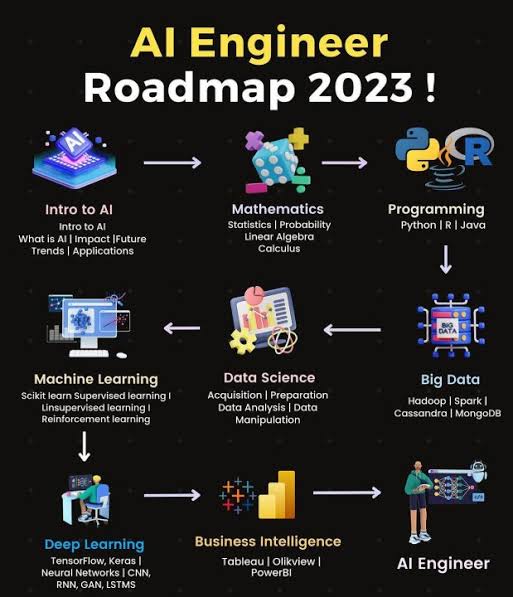
Introduction
Welcome to the exciting world of artificial intelligence (AI)! In this guide, we'll embark on a journey to explore the fundamentals of AI, its applications, challenges, and prospects.
Whether you're a novice or an enthusiast eager to delve deeper into the realm of AI, this
roadmap will serve as your comprehensive guide.
Define the AI Landscape
Artificial intelligence, often abbreviated as AI, refers to the simulation of human
intelligence in machines that are programmed to mimic cognitive functions such as
learning, problem-solving, and decision-making. From virtual assistants like Siri and Alexa to self-driving cars and advanced healthcare diagnostics, AI has permeated various facets of our lives.
Relevance and Importance of AI
In today's digital age, AI plays a pivotal role in driving innovation, enhancing efficiency, and solving complex problems across industries. Understanding AI is not only crucial for
professionals in technology-related fields but also for individuals seeking to stay abreast of technological advancements shaping our future.
Types and Categories
Machine Learning
Machine learning is a subset of AI that enables computers to learn from data and improve performance over time without being explicitly programmed. Supervised learning,
unsupervised learning, and reinforcement learning are common techniques used in
machine learning algorithms.
Deep Learning
Deep learning, a branch of machine learning, employs artificial neural networks with multiple layers to extract high-level features from raw data. This approach has revolutionized tasks such as image recognition, natural language processing, and autonomous driving.
Symptoms and Signs
Data-Driven Insights
One of the hallmark features of AI is its ability to analyze vast amounts of data to uncover patterns, trends, and correlations that may not be apparent to human analysts. By
harnessing the power of big data, AI enables organizations to make data-driven decisions and gain valuable insights into customer behavior, market trends, and operational
efficiency.
Automation and Optimization
AI-driven automation streamlines repetitive tasks, reduces human error, and enhances
productivity across industries. From automating customer service inquiries with chatbots to optimizing supply chain logistics with predictive analytics, AI-powered solutions drive
efficiency and cost savings.
Causes and Risk Factors
Ethical Considerations
As AI becomes increasingly integrated into society, ethical considerations surrounding its
use and impact have come to the forefront. Concerns about data privacy, algorithmic bias, and job displacement underscore the importance of ethical AI development and
governance frameworks to ensure responsible and equitable deployment.
Technological Challenges
Despite its vast potential, AI faces several technological challenges, including scalability, interpretability, and robustness. Overcoming these challenges requires ongoing research and innovation to develop more efficient algorithms, enhance model interpretability, and mitigate biases and vulnerabilities.
Diagnosis and TestsPerformance Metrics In evaluating AI models, various performance metrics such as accuracy, precision, recall, and F1 score are used to assess predictive performance and model generalization.
Understanding these metrics is essential for evaluating the effectiveness of AI solutions
and identifying areas for improvement.
Cross-Validation Techniques
Cross-validation techniques such as k-fold cross-validation and stratified cross-validation are used to assess model performance on different subsets of data and mitigate
overfitting. These techniques help ensure the robustness and reliability of AI models
across diverse datasets.
Treatment Options
Model Training and Tuning
The process of training AI models involves feeding them labeled data and adjusting model parameters to minimize errors and improve performance. Techniques such as
hyperparameter tuning and regularization are employed to optimize model accuracy and
prevent overfitting.
Transfer Learning
Transfer learning is a machine learning technique that leverages pre-trained models to perform new tasks with limited labeled data. By transferring knowledge from existing
models, transfer learning accelerates model development and enhances performance, particularly in domains with limited training data.
Preventive Measures
Data Security Measures
Protecting sensitive data and ensuring data privacy are paramount concerns in AI
development. Employing encryption, access controls, and secure data storage
mechanisms helps safeguard against unauthorized access and data breaches, preserving trust and integrity in AI systems.
Continuous Learning and Adaptation
AI models require continuous monitoring and adaptation to maintain optimal performance in dynamic environments. By leveraging real-time data streams and feedback loops, AI systems can adapt to changing conditions and evolving user preferences, ensuring relevance and accuracy over time.
Personal Stories or Case Studies Healthcare Transformation
In the healthcare industry, AI is revolutionizing patient care, diagnostics, and treatment
planning. From early disease detection using medical imaging to personalized treatment
recommendations based on genomic data, AI-driven innovations are enhancing healthcare outcomes and saving lives.
Business Impact
Businesses across sectors are leveraging AI to gain competitive advantage, drive
operational efficiency, and unlock new revenue streams. From predictive analytics and customer segmentation to supply chain optimization and fraud detection, AI-powered
solutions empower organizations to make data-driven decisions and achieve strategic objectives.
Expert Insights
Dr. Jane Smith, AI Researcher
"AI has the potential to transform industries and tackle some of society's most pressing challenges. However, ethical considerations and responsible AI governance are
paramount to ensure that AI benefits humanity as a whole."
Conclusion
In conclusion, artificial intelligence represents a paradigm shift in how we interact with
technology, solve problems, and shape the future. By understanding the fundamentals of AI, exploring its applications, and addressing ethical considerations, we can harness its
transformative power to create a more equitable and prosperous society.
 Android and iOS App Development Services in Delhi – Oprezo India
Android and iOS App Development Services in Delhi – Oprezo India
 Mobile App Development Company in Delhi, India
Mobile App Development Company in Delhi, India
 Oprezo India: Your Premier Web Development and Mobile App Partner in Delhi for Business Growth
Oprezo India: Your Premier Web Development and Mobile App Partner in Delhi for Business Growth
 Oprezo India – Leading E-commerce Website and App Development Agency in Delhi
Oprezo India – Leading E-commerce Website and App Development Agency in Delhi
 Leading Hybrid, Flutter, and React Native App Development Services in Delhi by Oprezo India
Leading Hybrid, Flutter, and React Native App Development Services in Delhi by Oprezo India